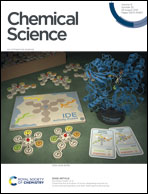An expanded halogen bonding scale using astatine†
Abstract
As a non-covalent interaction, halogen bonding is now acknowledged to be useful in all fields where the control of intermolecular recognition plays a pivotal role. Halogen-bond basicity scales allow quantification of the halogen bonding of referential donors with organic functional groups from a thermodynamic point of view. Herein we present the pKBAtI basicity scale to provide the community an overview of halogen-bond acceptor strength towards astatine, the most potent halogen-bond donor element. This experimental scale is erected on the basis of complexation constants measured between astatine monoiodide (AtI) and sixteen selected Lewis bases. It spans over 6 log units and culminates with a value of 5.69 ± 0.32 for N,N,N′,N′-tetramethylthiourea. On this scale, the carbon π-bases are the weakest acceptors, the oxygen derivatives cover almost two-thirds of the scale, and sulphur bases exhibit the highest AtI basicity. Regarding the applications of 211At in targeted radionuclide therapy, stronger labelling of carrier agents could be envisaged on the basis of the pKBAtI scale.



 Please wait while we load your content...
Please wait while we load your content...